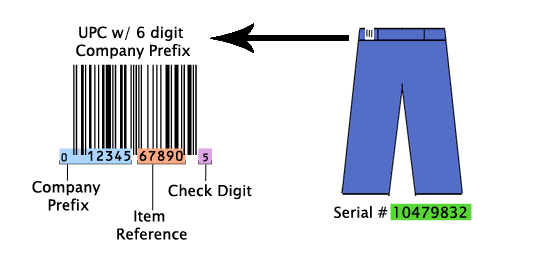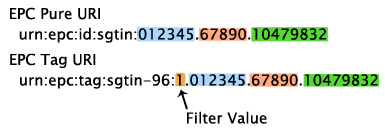SGTIN INFO
The EPC schema to encode a GTIN is the sgtin which consists of the GTIN plus a unique product or serial number. Below is an example of the relationship between the GTIN and primary forms of the EPC (Pure, Tag, and Binary.) The sgtin scheme has three different encodings 64, 96, and 198. Each encoding relates to the number of bits in the final EPC binary form. For this example we will be using the SGTIN-96 EPC scheme for a point of sale item, a pair of pants, along with its UPC and a serial number. The serial number distinguishes this specific pair of pants for all others that carry the same UPC. The various parts of the UPC have been highlighted to distinguish the company prefix from the product number and check digit. The company prefix is assigned by GS1, the item reference by the company, and the check digit is calculated automatically.
The various parts of the UPC have been highlighted to distinguish the company prefix from the product number and check digit. The company prefix is assigned by GS1, the item reference by the company, and the check digit is calculated automatically.
EPC Pure and Tag URI
Below are the first two EPC encodings that are used to represent data within data systems. The EPC Tag URI denotes the specific SGTIN encoding (SGTIN-96) as well as introduces the Filter Value which denotes the packaging level of the item. The Filter Value is “1” because the pair of pants is a point of sale item. A complete list of filter values can be found here.
Converting to Binary EPC
Step 1: Determine the binary header value for the EPC schema. The binary header value for SGTIN-96 is “00110000.” A complete list of binary header values can be found here.Step 2: Select the Partition Value based on the number of digits in the Company Prefix from the Partition Value Table. In this example the number of digits in the company prefix is 7 (there is an additional leading “0” not shown) which correlates to a partition value of “5.” The SGTIN-96 data schema provides 44 data bits and the Partition Value determines the number of bits used to encode the Company Prefix. The remaining bits encode the Item Reference.
Step 3: Convert the Filter Value, Partition Value, Company Prefix, Item Reference, and Serial # to binary value. (The binary values below have been padded with leading 0’s to fill their respective bit spaces. For example, with a partition value of “5” the Company Prefix bit space is 24 bits but the binary conversion is only 14 bits long thus it is padded with ten “0” bits.)
 Step 4: Concatenate in order Header, Filter, Partition, Company Prefix, Item Reference, and Serial # binary values to form the Binary EPC.
Step 4: Concatenate in order Header, Filter, Partition, Company Prefix, Item Reference, and Serial # binary values to form the Binary EPC.




